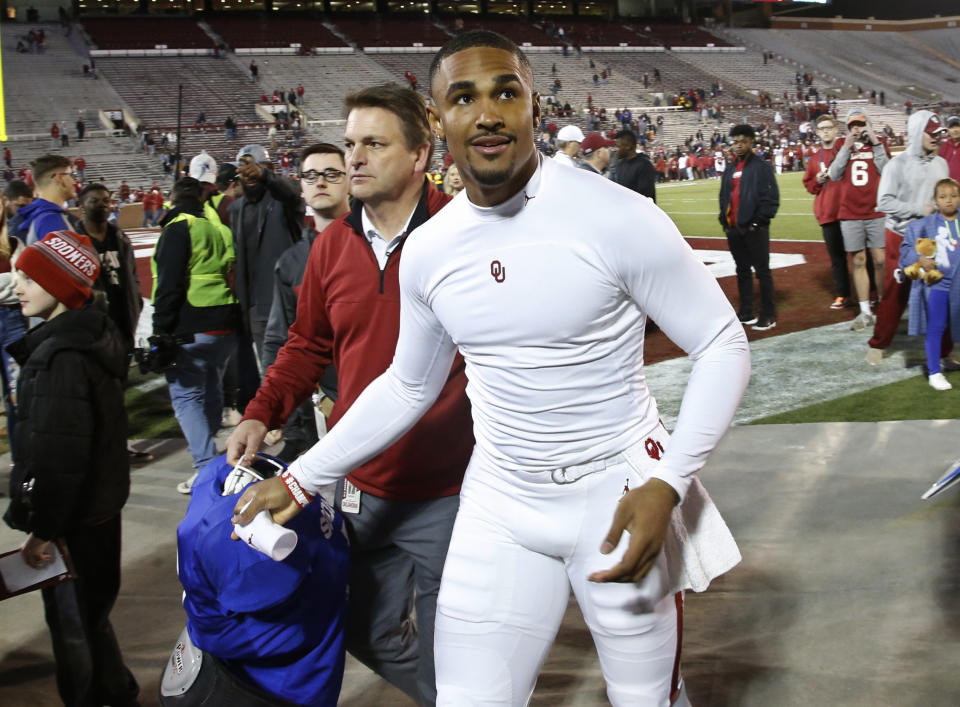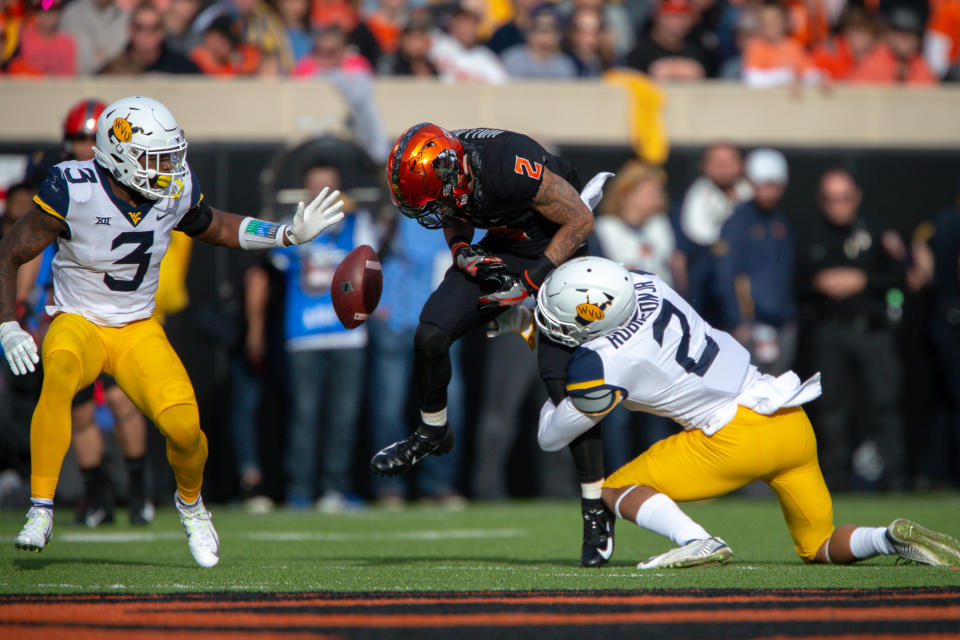Winners and losers of the college football transfer portal
We’re getting closer and closer to the month of August, and that means college football preseason practice is around the corner. But before we fully dive in and begin forecasting what lies ahead for the 2019 season, it’s worthwhile to assess the storyline that dominated the offseason: the transfer portal.
The transfer portal, announced last June and officially implemented Oct. 15, 2018, created a world where college athletes did not need permission from their school in order to transfer. In the months since, hundreds of players have entered their names into the portal, allowing some teams to fill critical roster needs while others lost some of their top talent.
There are still more moves to come in the next few weeks, but now is as good a time as any to compile the winners and losers from the offseason of the transfer portal. Some of these moves will dramatically impact the course of the coming season.
Winners
Missouri
Missouri shored up its quarterback room for years to come via the transfer portal by bringing in ex-Clemson signal caller Kelly Bryant and Shawn Robinson, formerly of TCU. Bryant, who started 18 games for Clemson before Trevor Lawrence proved to be too good to keep off the field, will immediately slide into the starting role for the Tigers after Drew Lock’s four-year run. Robinson, meanwhile, will have two years to play after a redshirt year. One of Bryant’s main weapons could be Jonathan Nance, a graduate transfer receiver from Arkansas who caught 37 balls for 539 yards and five scores in 2017.
But above all, Missouri deserves praise because it did not lose a single player after being delivered a postseason ban for the 2019 season. When a program is hit with a postseason ban, the NCAA allows that team’s seniors to transfer without penalty. But Barry Odom and his staff kept the locker room together.
Oklahoma
The Sooners did it again. OU’s last two starting quarterbacks, Heisman winners Baker Mayfield and Kyler Murray (you may have heard of them), arrived in Norman as transfers. And when Murray departed for the NFL, Lincoln Riley brought in another big time player in Jalen Hurts. Hurts accomplished a ton at Alabama but ultimately lost his starting job to Tua Tagovailoa, last year’s Heisman runner-up. At Oklahoma, he will get to play out his final season in a high-flying offense and show off the improvements he has made as a passer.
The addition of Hurts sent Austin Kendall, Murray’s backup in 2018, to West Virginia, where he could start. A few defensive depth pieces transferred, too, but adding Hurts and ex-Virginia offensive lineman R.J. Proctor, another graduate transfer, should prove to be important in 2019 for OU.

Miami
Once he got the head job in his hometown, Manny Diaz hit the transfer portal hard. Not only did he bring in his potential starting quarterback in Ohio State transfer Tate Martell, Diaz scoured the market for help at receiver and at every level of his defense. K.J. Osborn, a graduate transfer receiver from Buffalo who caught 53 passes last fall, has made such a positive impression on the Hurricanes that he represented the program at ACC media days.
While Martell and Osborn are the notable additions on offense (as was Jeff Thomas’ decision to renege on his commitment to Illinois and return to the Canes), Miami snagged Trevon Hill from division rival Virginia Tech while landing a trio of talented defenders from out West: ex-UCLA defensive tackle Chigozie Nnoruka, ex-UCLA pass rusher Jaelan Phillips and ex-USC safety Bubba Bolden. Phillips and Bolden were both heralded recruits in the class of 2017.
USC
There always seems to be some sort of drama emanating out of USC, but things trended positively for Clay Helton’s program as the offseason progressed. The Trojans welcomed back five-star recruit Bru McCoy, who signed with USC out of high school before quickly departing for Texas. McCoy had a change of heart, however, and is now back at USC. Another top-tier recruit, defensive back Chris Steele, left Florida after enrolling early in Gainesville and landed at USC.
While McCoy and Steele could sit out in 2019 (both have applied for waivers), the Trojans nabbed a big grad transfer addition in Drew Richmond, an offensive tackle who started last year at Tennessee. Elsewhere, quarterback Matt Fink, receiver Velus Jones and cornerback Greg Johnson all decided to stick with the Trojans after entering their names in the portal. Though USC did lose its fair share of players, its new additions make the losses much easier to withstand.
Note: A previous version of this a story indicated that Chris Steele was sitting out in 2019. However, he has applied for a waiver and is awaiting a response from the NCAA. We regret the error.
Maryland
Mike Locksley relied on his deep connections to the D.C.-Maryland-Virginia area to bring some locals onto the Terps roster. On defense, linebackers like Keandre Jones (Ohio State) and Shaq Smith (Clemson) were big-time recruits who never really seized full-time starting jobs at their previous schools. They’ll get that chance at Maryland while finishing out their college careers in their home state. Sean Savoy, a D.C. native who played receiver at Virginia Tech, has been moved to corner. Smith and Savoy are immediately eligible. Jones is waiting on a waiver request from the NCAA.
Meanwhile, the offense received a big boost when quarterback Josh Jackson chose the Terps. Jackson, who has two years remaining and can play in 2019, started 16 games for the Hokies and threw for 3,566 yards and 25 touchdowns. Jackson, if he wins the starting job like expected, will get help from another transfer, ex-Buffalo tight end Tyler Mabry.

Mississippi State
Joe Moorhead added two big pieces to his offense for 2019. Perhaps of most importance, Moorhead called back to his time at Penn State and brought in quarterback Tommy Stevens to compete against Keytaon Thompson for the Bulldogs’ starting job. Stevens stuck it out for years behind Trace McSorley in Happy Valley, but decided to part ways when he wasn’t assured the starting job coming out of spring camp. Stevens always showed flashes when PSU put him in the game, and now he’ll get a chance to lead an SEC team during his final college season. Whether it’s Stevens or Thompson at quarterback, MSU will have Isaiah Zuber in the mix at receiver. The Kansas State transfer has 127 career catches over the last three seasons and should make an immediate impact.
Losers
West Virginia
When he took the West Virginia job, Neal Brown looked like he was in for a rebuilding year in 2019. And that was before some leaders on his team decided to leave Morgantown. The team’s two top returning safeties, Kenny Robinson Jr. and Derrek Pitts, both opted to enter the transfer portal. While the next step for Robinson Jr., a first-team all-Big 12 selection in 2018, is up in the air, Pitts has already landed down the road at Marshall. Another notable defection came on offense with Marcus Simms, a receiver with 87 career catches, opting for the NFL supplemental draft.
While those losses could be tough to overcome in 2019, Brown added some talent to the roster, too. Most notably, he landed Oklahoma transfer QB Austin Kendall, who could be the team’s starter. Jarret Doege, a quarterback who started 17 games at Bowling Green, also ended up at WVU. Another player who could help in 2019 is George Campbell, a receiver transfer from Florida State who never quite lived up to his lofty recruiting billing.

Illinois
The Fighting Illini were very active in the transfer market and those efforts will help the team in 2019, but things could have been significantly better. Three different wide receivers made commitments to play at Illinois, only to reconsider. First it was Miami’s Jeff Thomas who had a change of heart and returned to the Hurricanes. Later in the offseason, Oklahoma’s A.D. Miller did the same. To make matters worse, Dejon Brissett, an all-conference performer at FCS Richmond, backed away from his pledge to the Illini and instead enrolled at Virginia. Ouch. On top of all that, Luke Ford, a talented tight end transfer from Georgia, had his waiver for immediate eligibility perplexingly turned down by the NCAA. Illinois also lost two quarterbacks, Cam Thomas and M.J. Rivers, plus starting defensive back Cameron Watkins to transfer.
But it wasn’t all bad. Illinois added Brandon Peters, a quarterback with starting experience at Michigan, and ex-Alabama offensive lineman Richie Petitbon as graduate transfers. A trio of former USC players, WR Trevon Sidney, WR Josh Imatorbhebhe and LB Oluwole Betiku Jr., all chose Illinois and are expected to be immediately eligible.
Penn State
From a sheer volume perspective, Penn State was near the top in terms of players in the portal among Power Five programs. Two departures, the aforementioned Stevens to Mississippi State, and Juwan Johnson to Oregon were the most notable. Johnson was a breakout performer for the Nittany Lions in 2017 when he had 54 catches for 701 yards, but was nowhere near as consistent in 2018. Johnson will get a chance to play with possible No. 1 pick Justin Herbert in Eugene and put himself back on the NFL radar.
Beyond Stevens and Johnson, the majority of PSU’s departures were upperclassmen getting pushed on the depth chart by high-profile recruits from recent classes. But those losses could prove costly from a depth perspective if PSU deals with some injury issues.
Virginia Tech
The ACC Coastal feels wide open entering 2019 with Virginia Tech right in the mix. But the Hokies might feel a little better entering the season had they not lost a bunch of experienced players to the transfer portal. Jackson’s departure to Maryland was a big loss, but Ryan Willis, who landed with VT after a transfer of his own, could prove to not be much of a drop-off. But guys like Savoy (Maryland), wide receiver Eric Kumah (Old Dominion) and tight end Chris Cunningham (Old Dominion) all would have contributed to the Hokies’ offense. Trevon Hill (Miami), cornerback Bryce Watts (North Carolina) and linebacker Aundre Kearney (UCF) all could have been in the mix to start on defense.

Louisville
Louisville experienced a significant number of transfers following the much-needed firing of Bobby Petrino. After the disaster that was UL’s 2018 season, Scott Satterfield, formerly of Appalachian State, needed to start fresh. With that comes in excess of 20 scholarship players in the transfer portal. Jonathan Greenard (Florida), a defensive end with 22.5 tackles for loss and 9.5 sacks in his career, was probably the biggest loss. Three running backs (Colin Wilson, Trey Smith and Malik Staples) and two reserve quarterbacks (Jordan Travis and Sean McCormack) also left the Cardinals.
Group of 5 programs
It’s a prominent trend in college basketball that is becoming increasingly more common in college football. Based on the data in 247Sports’ transfer portal database, 36 players transferred from a Group of Five program up to a Power Five program this offseason. The MAC led the way with 10 such occurrences, while the AAC and C-USA had eight such defections each. The Sun Belt had six players transfer up, four of which left South Alabama, while four players left the Mountain West.
More from Yahoo Sports:

 Yahoo Lifestyle
Yahoo Lifestyle 
